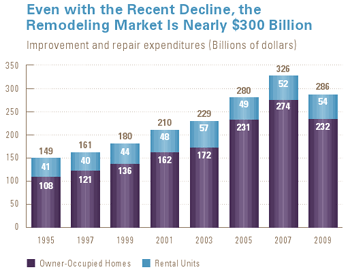The U.S. home improvement industry is emerging from its worst downturn since the government began tracking spending in the early 1960s, according to a new report from the Joint Center for Housing Studies of Harvard University.
At almost $290 billion in 2009, the remodeling market held up much better than new residential construction during the downturn. Indeed, the maintenance component of remodeling expenditures increased slightly in 2007–9—not surprising since this spending category tends to remain fairly stable across cycles.
“As both the economy and the housing market stabilize, so too will homeowner improvement spending,” said Abbe Will, a researcher with the Remodeling Futures Program at the Joint Center for Housing Studies. In the coming years, remodeling expenditures are expected to increase at an inflation-adjusted average annual rate of 3.5%–below the pace recorded during the housing boom of the part of the first decade of the 2000s, but up sharply from the recent downturn.
“A New Decade of Growth for Remodeling” is the sixth and latest report in the “Improving America’s Housing” series published by the Remodeling Futures Program.
The industry, which saw a double-digit decline since its peak in 2007, is beginning to return to a more typical pattern of growth, the report concludes. Market fundamentals—the number of homes in the housing stock, the age of those homes, and the income gains of homeowners making improvements—all point to increases in remodeling spending.
“Metropolitan areas with rising house prices, older housing stocks, higher incomes and home values, and a larger share of upscale remodeling expenditures, such as Boston, San Francisco, and Los Angeles, are well-positioned for an upturn in remodeling activity,” said Eric Belsky, managing director of the Joint Center for Housing Studies.
In the next five years, the focus of remodeling spending will shift from upper-end discretionary projects to replacements and systems upgrades, the report suggests. Remodeling contractors will be able to capitalize on a number of growth opportunities generated by underinvestment in distressed properties, lower mobility, changing migration patterns, and the rise of environmental awareness.
“Lower household mobility following the housing-market crash means that in the coming years homeowners will increasingly focus on improvements with longer paybacks, particularly energy-efficient retrofits,” said Kermit Baker, director of the Remodeling Futures Program at the Joint Center. “Also, a slowing of migration to traditionally fast-growing Sunbelt metro areas means that, at least temporarily, more remodeling spending will remain in older, slower-growing areas in the Rustbelt and in California.”
Copies of the report are available at Harvard Remodeling Industry Report.

